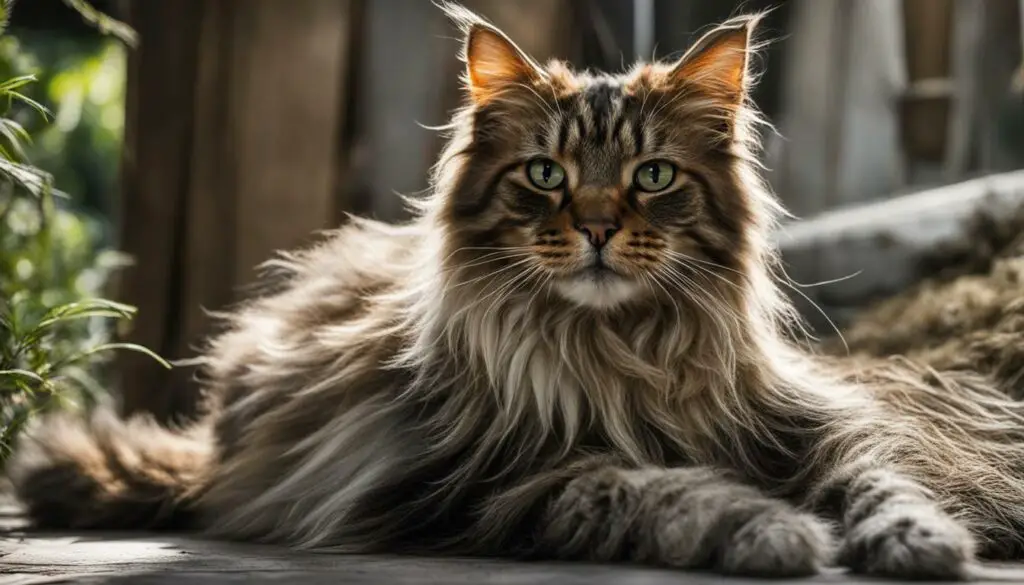Grooming is an essential part of caring for our feline friends, especially when it comes to dealing with severely matted fur. Mats, which are clumps of dead hair, oily skin cells, and debris, can be a source of discomfort and potential health issues for cats. But how should we approach the removal of these mats without causing harm to our furry companions?
When a cat develops matting, it is crucial to understand the safest and most effective options for removal. Using scissors or sharp tools may seem like a solution, but they can actually cut and damage the cat’s delicate skin. Dematting sprays and conditioners also prove to be ineffective in removing mats.
Instead, the safest methods for mat removal are shaving or gentle combing, depending on the size, location, and condition of the mats and the cat’s behavior. It’s important to address mats promptly to prevent further discomfort and potential health issues for our beloved pets.
Key Takeaways:
- Severely matted fur can cause discomfort and health issues for cats.
- Scissors and sharp tools should be avoided as they can harm the cat’s skin.
- Dematting sprays and conditioners are not effective in removing mats.
- Shaving or gentle combing are the safest methods for mat removal.
- Promptly addressing mats is crucial to prevent further discomfort and health issues.
Understanding Severely Matted Cat Fur
Cat fur plays a crucial role in a cat’s overall health and well-being. Understanding the nature of cat fur and the importance of proper grooming techniques is essential for cat owners. Cat hair, or fur, is made up of two layers: the topcoat and the undercoat. The topcoat consists of longer, coarser hairs that provide protection from the elements, while the undercoat is softer and denser, providing insulation.
In order to maintain a healthy cat coat, regular grooming is necessary. This includes brushing, combing, and removing any tangles or mats that may have formed. Severely matted cat fur is a common problem, especially in long-haired breeds. Mats are clumps of tangled hair that can be painful for cats and lead to skin irritation and even infections. Regular grooming and brushing can help prevent the formation of mats by removing loose hair and preventing tangles.
Grooming Techniques for Severely Matted Cat Fur
When dealing with severely matted cat fur, it is important to approach the grooming process with caution. Cats are sensitive creatures, and their skin can be easily injured if not handled properly. The first step is to assess the severity of the matting. If the mats are small and not causing any discomfort to the cat, they can be carefully combed out using a metal comb with wide teeth. However, if the mats are large, tight, or in sensitive areas, it is best to consult a professional groomer or veterinarian who can safely shave the cat’s fur.
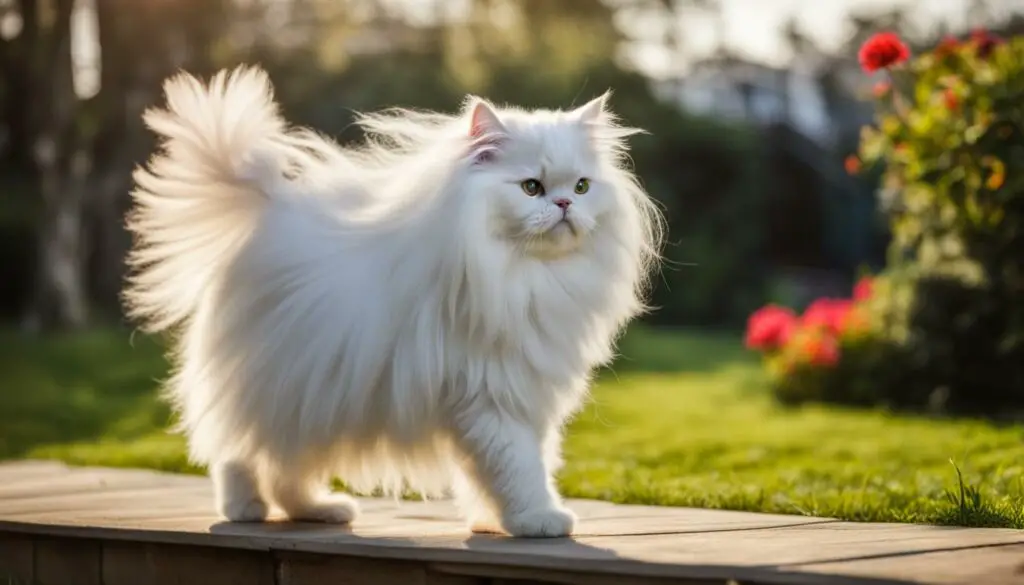
| Grooming Technique | Description |
|---|---|
| Combing Out Mats | For small mats, use a wide-toothed metal comb to carefully work through the tangles. Hold the base of the mat firmly and gently comb through, working from the outside of the mat inwards. Be patient and use short, gentle strokes to avoid pulling the cat’s hair. |
| Shaving the Fur | If the mats are large or tightly knotted, shaving may be necessary. It is recommended to seek the help of a professional groomer or veterinarian for this process. They have the expertise and tools to safely shave the cat’s fur without causing any harm. |
| Preventing Future Matting | After removing the mats, it is crucial to establish a regular grooming routine to prevent future matting. This includes regular brushing and combing to remove loose hair and prevent tangles. Using grooming tools specifically designed for cats can make the process easier and more effective. |
Grooming severely matted cat fur requires a gentle and careful approach to ensure the cat’s comfort and safety. By understanding the nature of cat fur and using appropriate grooming techniques, cat owners can help maintain their cat’s coat and prevent the formation of mats. Regular grooming not only keeps the cat’s fur looking clean and healthy but also contributes to their overall well-being.
The Dangers of Severely Matted Fur
Severely matted fur can have serious implications for a cat’s health and hygiene. Neglecting to address matting can lead to discomfort, pain, and even more severe health issues. The matted fur puts pressure on the skin, causing bruising and irritation. It also prevents proper airflow and traps dirt, bacteria, and parasites, which can lead to infections and infestations. Additionally, the skin underneath the mats becomes thin and fragile, making it more susceptible to injuries. It is essential to understand the risks associated with severely matted fur and take timely action to ensure the cat’s well-being.
When a cat’s fur is severely matted, it is often an indication of neglect or underlying health problems. Cats who have stopped grooming themselves altogether may be experiencing health issues that require medical attention. Neglecting proper grooming can also lead to matting, as the cat’s natural grooming process is not sufficient to prevent mats. Regular grooming is crucial not only for maintaining the cat’s appearance but also for promoting their overall health and hygiene. Cats rely on their owners to ensure that their grooming needs are met, and neglecting this responsibility can have severe consequences.
Severely matted fur is a welfare concern for cats. It can cause continuous discomfort, pain, and stress, affecting their quality of life. Cats with matted fur may exhibit changes in behavior, such as increased irritability or withdrawal. It is important for cat owners to prioritize their pet’s welfare and take proactive measures to prevent and address matting. Regular grooming, along with proper nutrition and veterinary care, is essential for maintaining a healthy and happy cat. By prioritizing cat care and hygiene, we can ensure that our feline companions live a life free from the dangers of severely matted fur.
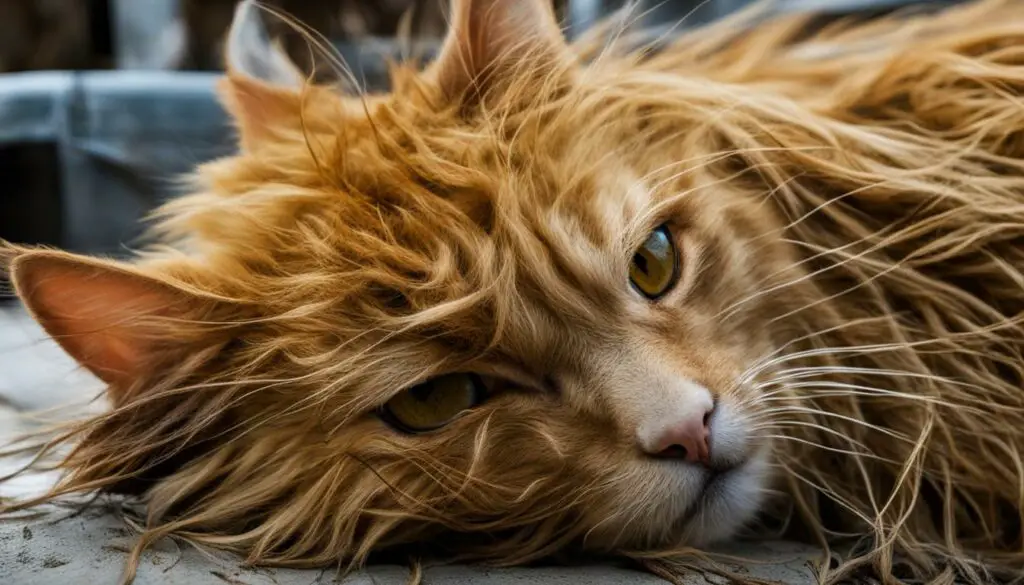
The Importance of Regular Grooming
Regular grooming plays a crucial role in preventing severely matted fur and ensuring the overall well-being of cats. It allows us to monitor their coat and skin health, identify any underlying issues, and address them promptly. Grooming also helps strengthen the bond between the cat and the owner, as it provides an opportunity for physical contact and affection.
Grooming involves more than just brushing the cat’s fur. It includes checking their ears, eyes, and teeth, trimming their nails, and maintaining cleanliness. By incorporating grooming into our routine, we can keep our cats healthy, comfortable, and happy.
| Grooming Tips | Cat Health Benefits |
|---|---|
| Regular brushing and combing | Prevents matting and skin issues |
| Checking ears, eyes, and teeth | Early detection of infections or abnormalities |
| Trimming nails | Avoids overgrowth and potential injury |
| Maintaining cleanliness | Prevents odor and discomfort |
Ensuring regular grooming for our cats is not only a responsibility but also an act of love. It shows that we care for their well-being and are committed to providing them with a comfortable and healthy life.
How to Remove Small Mats
When dealing with small mats in your cat’s fur, it’s important to approach the removal process carefully to avoid causing any discomfort or harm. Using the right grooming tools and techniques can help you effectively remove these mats without causing any stress to your feline friend.
Grooming Tools for Small Mats
To remove small mats, you will need a sturdy metal comb with fine teeth. This type of comb can help untangle the hair and gently work out the mats without pulling too much hair. It’s important to choose the right-sized comb that can fit under the mats without causing any additional pain or discomfort to your cat.
When using the comb, hold the mat firmly at the base with your fingers, and then slide the comb underneath the mat. Gently work the comb through the mat in one swift tug, freeing the hair from the tangles. This technique can be effective for small mats that are approximately the size of a nickel or smaller.
Shaving as an Alternative
Although combing out small mats is the preferred method, there may be certain areas where shaving is necessary, even if the mats fit the size recommendations. Areas such as behind the ears, the sanitary area, and other sensitive areas may require shaving to ensure complete mat removal and prevent any future discomfort for your cat.
Remember to always approach the grooming process with patience and gentle hands. If you’re unsure or uncomfortable with removing small mats, it’s best to seek professional help from a groomer or veterinarian who can safely and effectively remove the mats without causing any harm to your beloved feline companion.
| Grooming Tools | Techniques |
|---|---|
| Sturdy metal comb with fine teeth | Hold the mat firmly at the base and gently slide the comb underneath, working out the mat in one swift tug |
| Shaving (if necessary) | For areas where combing is not possible or practical |
How to Safely Shave Severely Matted Fur
Grooming a cat with severely matted fur requires careful attention and proper techniques to ensure the cat’s safety and comfort. Shaving is often the best option for removing large, tight, or sensitive mats. However, it is essential to use the right tools and approach to avoid injuring the cat’s delicate skin.
When shaving severely matted fur, it is recommended to use pet clippers with a #10 blade. These clippers are designed for safe and efficient grooming. It is crucial to work on small sections at a time, focusing only on areas where the mats can be fully seen. This approach helps prevent accidental cuts or abrasions.
“Shaving is a professional skill.”
Securing the cat during the grooming process is also important to prevent movement and stress. This can be done by gently restraining the cat or using professional grooming tools that provide a secure hold. If you are unsure or uncomfortable with the shaving process, it is advisable to seek the assistance of a professional groomer or veterinarian.
Expert Tips for Safely Shaving Severely Matted Fur
To ensure the safety and comfort of your cat during the shaving process, here are some expert tips:
- Invest in high-quality pet clippers with a #10 blade for safe and efficient grooming.
- Work on small sections at a time, focusing only on areas where mats are visible.
- Secure the cat using proper restraint techniques or professional grooming tools.
- Seek professional help if you are unsure or uncomfortable with the shaving process.
Table: Safe Tools for Shaving Severely Matted Fur
| Grooming Tool | Description |
|---|---|
| Pet Clippers with #10 Blade | Designed for safe and efficient grooming, suitable for removing mats. |
| Restraining Tools | Professional grooming tools that securely hold the cat during grooming. |
Remember, shaving severely matted fur is a professional skill that requires expertise and caution. Prioritize your cat’s safety and seek professional assistance if needed.
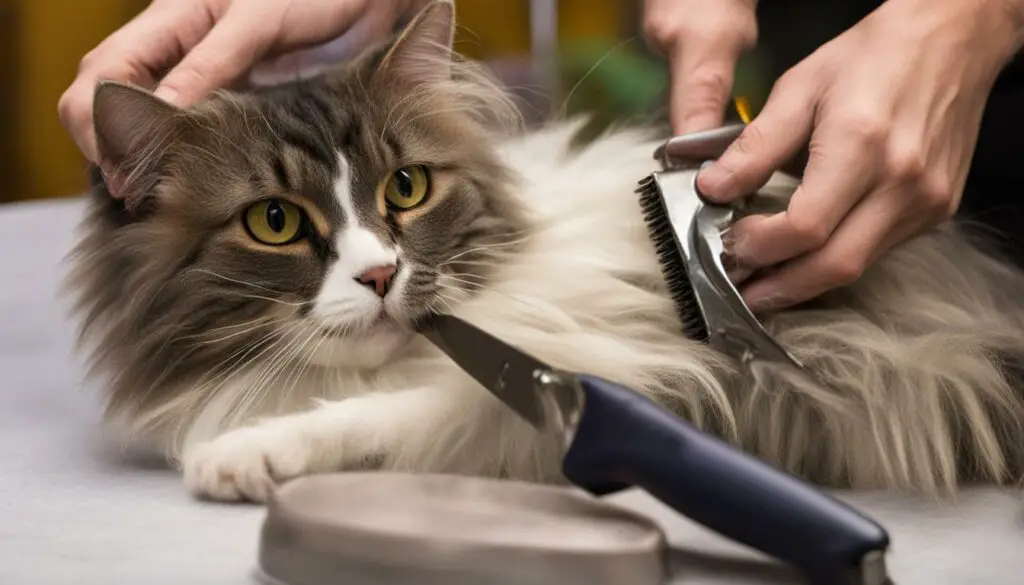
When to Seek Professional Help for Severely Matted Fur
Dealing with severely matted fur can be a challenging task, especially if the cat is uncooperative or the mats are large and causing discomfort. In such cases, it is essential to seek professional help from experienced groomers or veterinarians who specialize in cat grooming. These professionals have the necessary skills, knowledge, and equipment to safely remove mats and provide proper care for your cat’s coat and skin.
Professional groomers are trained in handling cats and can assess the condition of the matting, the cat’s skin, and behavior to determine the best course of action. They can use their expertise to minimize stress and discomfort for your cat during the grooming process. Additionally, groomers can provide valuable advice and tips on maintaining your cat’s coat and preventing severe matting in the future.
| Benefits of Seeking Professional Help | Cat Welfare Organizations |
|---|---|
| Safe mat removal without causing harm or injury to the cat | Cat Rescue |
| Expert knowledge and experience in handling severely matted fur | Cat Adoption |
| Proper grooming equipment and techniques for effective mat removal | Cat Welfare Organizations |
| Reduced risk of infections and skin irritations |
Professional groomers can effectively address severe matting, even in difficult-to-reach areas such as behind the ears or the sanitary area. They can use appropriate tools and techniques to carefully remove mats without causing any harm to your cat’s delicate skin. In some cases, a veterinarian may be needed to perform the groom under anesthesia for the cat’s safety and comfort.
By seeking professional help, you can ensure that your cat receives the necessary care and attention to alleviate the discomfort caused by severely matted fur. Cat groomers and veterinarians play a crucial role in maintaining your cat’s coat and overall health. Don’t hesitate to reach out to them for assistance and advice when dealing with severe matting.
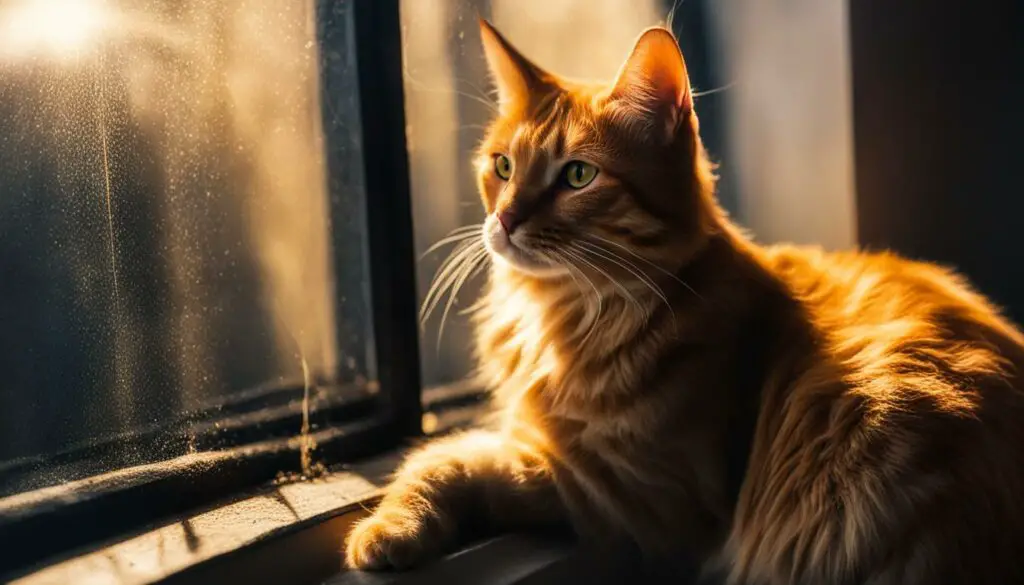
Post-Mat Removal Care
After the mats have been safely removed from your cat’s fur, it’s important to provide post-mat removal care to ensure their comfort and promote healing. Here are some essential steps to follow:
- Monitor the skin: Check your cat’s skin for any signs of infection or irritation that may have been hidden under the mats. Look for redness, swelling, or oozing, which could indicate an underlying issue that needs attention.
- Healing bald spots: It’s normal for your cat to have bald spots after mat removal. These areas will typically heal on their own without additional treatment. However, keep an eye on them to ensure they are healing properly and not becoming infected.
- Preventing hot spots: Cats may develop hot spots, which are areas of irritated and inflamed skin, especially after mat removal. Watch for excessive licking or scratching in a particular area and consult your veterinarian if you notice any signs of hot spots.
- Continuing regular grooming: To prevent further matting, establish a consistent grooming routine for your cat. This includes regular brushing and combing sessions using appropriate cat grooming supplies. Maintaining a healthy coat will help prevent future matting issues.
Remember, every cat is unique, and their post-mat removal care may vary. Keep a close eye on your cat’s behavior and skin condition, and consult with a veterinarian if you have any concerns or questions.
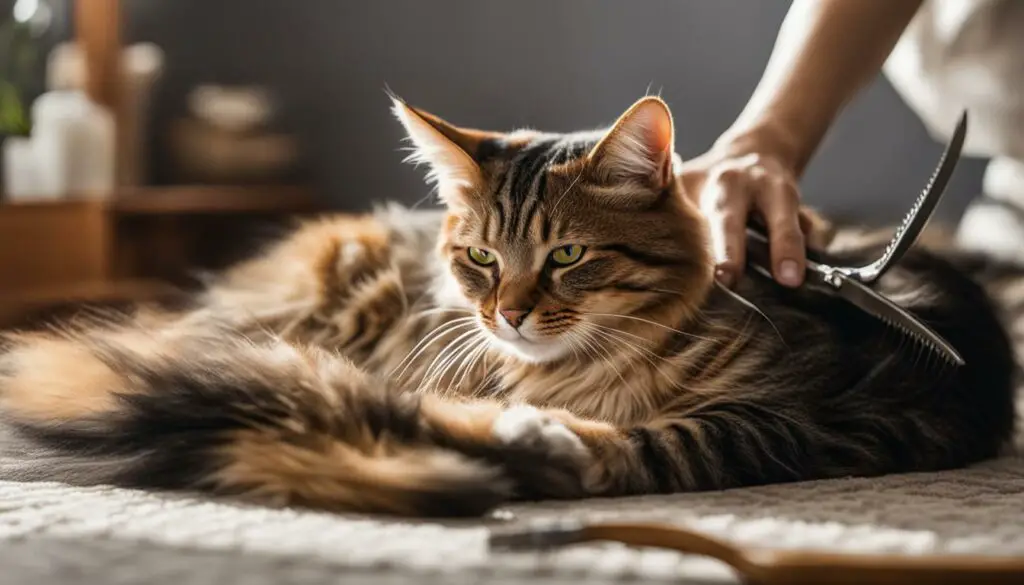
Suggested Grooming Products:
| Grooming Product | Description |
|---|---|
| Grooming Brush | A soft-bristle brush that gently removes loose hair and prevents tangles. |
| Dematting Comb | A comb with wide-spaced teeth for safely removing small mats and tangles. |
| Grooming Wipes | These wipes are handy for quickly cleaning your cat’s fur and reducing odors between grooming sessions. |
| Conditioning Spray | A moisturizing spray that helps detangle and soften the fur, making it easier to brush. |
| Nail Clippers | To maintain your cat’s nail health and prevent scratching-related accidents, use cat-specific nail clippers. |
“Post-mat removal care is crucial for your cat’s comfort and well-being. By following these steps and using the right grooming products, you can help your cat recover from the matting and prevent future problems.”
Cat Grooming Tips, Tools, and Techniques
Grooming your cat is an essential part of maintaining their overall health and well-being. Regular grooming sessions not only keep their coat clean and free from mats but also provide an opportunity for bonding between you and your feline friend. Here are some useful cat grooming tips, tools, and techniques to ensure a comfortable and effective grooming experience:
Tips for Effective Cat Grooming
1. Start early: Introduce grooming to your cat from a young age, so they become familiar and comfortable with the process.
2. Use positive reinforcement: Reward your cat with treats and praise during grooming sessions to create a positive association.
3. Choose the right tools: Invest in good-quality grooming tools, such as a slicker brush, comb, and nail clippers specifically designed for cats.
4. Be gentle and patient: Handle your cat with care and take breaks if they become stressed or agitated during grooming.
5. Take it slow: Gradually increase the duration of grooming sessions to allow your cat to adjust and feel more relaxed.
6. Watch for signs of discomfort: Pay attention to your cat’s body language and stop immediately if they show signs of distress or pain.
Essential Cat Grooming Tools
Here are some essential grooming tools every cat owner should have:
| Grooming Tool | Description |
|---|---|
| Slicker Brush | A brush with fine, short wires that helps remove loose fur and prevent matting. |
| Comb | A wide-toothed comb for detangling and removing mats from the cat’s coat. |
| Nail Clippers | Special clippers designed for cats to trim their claws safely. |
| Ear Cleaner | A gentle ear cleaning solution to remove dirt and debris from the cat’s ears. |
Effective Cat Grooming Techniques
Follow these techniques for a successful grooming session:
- Start by brushing: Use a slicker brush to remove loose fur and prevent matting. Brush in the direction of hair growth, starting from the head to the tail.
- Check for mats: Use a comb to gently comb through the cat’s fur and identify any mats or tangles. Carefully separate the hairs around the mat and try to comb it out.
- Trim the nails: Use cat-specific nail clippers to trim the sharp tips of your cat’s nails. Be cautious not to cut into the quick, a sensitive area with blood vessels.
- Check the ears and eyes: Gently clean the cat’s ears with an ear cleaner and use a damp cloth to wipe away any discharge around the eyes.
- Praise and reward: End the grooming session with praise, treats, or a favorite toy to reinforce positive behavior and make the experience more enjoyable for your cat.
Remember, grooming is not only about keeping your cat looking their best but also ensuring their comfort and preventing health issues. By following these cat grooming tips, using the right tools, and employing effective grooming techniques, you can maintain a happy and healthy cat.
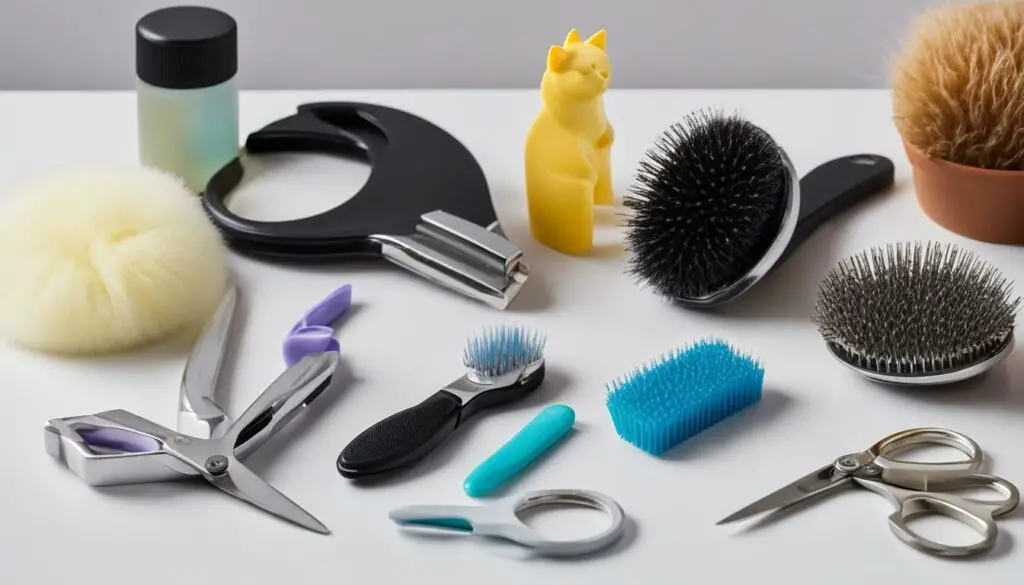
The Importance of Cat Grooming
Cat grooming behavior, habits, needs, and problems are all essential aspects to consider when caring for your feline companion. Grooming plays a vital role in maintaining their overall health and well-being. It not only keeps their coat clean and free from tangles and mats but also helps prevent skin issues and other health problems.
Grooming is a natural behavior for cats, but some may need assistance in maintaining their hygiene, especially if they have certain health conditions or difficulty reaching certain areas of their body. Regular grooming sessions provide an opportunity for bonding between you and your cat, strengthening your bond and trust.
Understanding the importance of grooming can help cat owners prioritize the necessary care for their furry friends. It allows you to detect any potential skin issues, lumps, or bumps that may require veterinary attention. Additionally, regular brushing helps distribute natural oils throughout your cat’s coat, promoting a healthy shine and preventing excessive shedding.
Benefits of Cat Grooming:
- Promotes a healthy coat and skin
- Prevents matting, tangles, and knots
- Reduces shedding and hairballs
- Prevents the formation of fleas and ticks
- Allows for early detection of skin issues, lumps, or bumps
Grooming your cat should be a positive experience for both you and your feline friend. Start by introducing them to grooming gradually, using gentle techniques and providing plenty of praise and rewards. Be mindful of their comfort and stress levels, ensuring a calm environment during grooming sessions.
| Grooming Tips: | Frequency: |
|---|---|
| Brushing | At least once a week for short-haired cats, daily for long-haired cats |
| Nail Trimming | Every 2 to 4 weeks |
| Ear Cleaning | Once a month or as needed |
| Toothbrushing | Daily or as advised by your veterinarian |
Regular grooming not only benefits your cat’s physical health but can also have a positive impact on their mental well-being. It helps to reduce stress and anxiety, providing a sense of comfort and security. By maintaining a consistent grooming routine and being attentive to your cat’s needs, you can ensure their comfort and overall happiness.
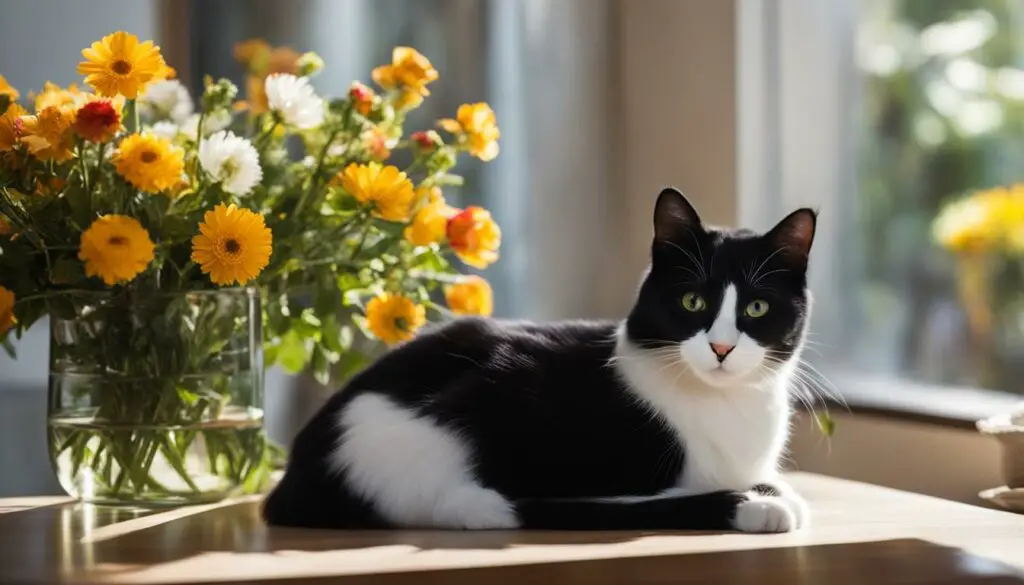
Ensuring Your Cat’s Comfort During Grooming
Grooming can be a stressful experience for cats, but there are steps you can take to ensure their comfort and minimize their stress. Understanding your cat’s behavior and providing a calm environment are key to creating a positive grooming experience.
First, it’s important to introduce grooming sessions gradually. Start by simply touching and stroking your cat in areas that will eventually need grooming, such as the back, sides, and tail. This will help your cat become accustomed to being touched in those areas and build trust.
When it’s time for an actual grooming session, choose a quiet and peaceful area where your cat feels safe. You can also try using calming techniques, such as playing soft music or using pheromone sprays designed to reduce anxiety. Make sure to use gentle and patient handling throughout the grooming process, rewarding your cat with treats and praise for good behavior.
If your cat becomes too stressed or anxious during grooming, it’s important to take breaks and never force them to continue. It’s better to have shorter and more frequent grooming sessions than one long and stressful session. Remember, grooming should be a positive experience for both you and your cat.
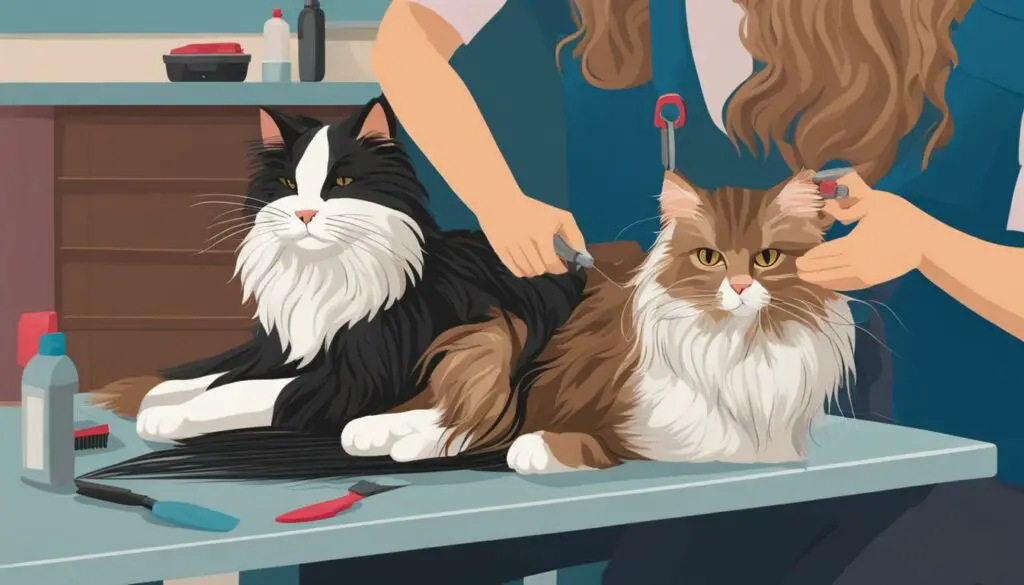
Benefits of Cat Grooming
Grooming your cat regularly not only helps maintain their coat but also offers several other benefits. Firstly, grooming promotes healthy skin by removing dead skin cells and distributing natural oils. This can help prevent dryness and flakiness.
In addition, grooming allows you to check your cat’s overall health. By observing their skin, coat, ears, and paws, you can detect any abnormalities or signs of health issues early on. Regular grooming also helps prevent the formation of mats, which can be painful for cats and lead to skin irritation and infections.
Furthermore, grooming provides an opportunity for bonding and strengthening the relationship between you and your cat. The gentle touch and quality time spent together during grooming can help create a deeper connection and mutual trust.
Grooming Tips for Different Cat Breeds
Grooming cats requires understanding the unique needs of different breeds. Each cat breed has its own specific grooming requirements and styles to maintain their beautiful coats. By following breed-specific grooming techniques and using the right supplies, cat owners can ensure their feline friends look and feel their best.
Long-Haired Breeds
Long-haired breeds like Persians and Maine Coons require more frequent and thorough grooming to prevent matting. These cats have luxurious coats that can easily become tangled and matted if not properly cared for. Regular brushing with a wide-toothed comb or slicker brush is essential to remove loose hair and prevent knots. Pay extra attention to areas prone to matting, such as behind the ears and under the armpits. It may be necessary to gently use dematting tools or scissors to remove any stubborn mats, but caution should be taken to avoid injuring the cat’s skin. Professional grooming can also help maintain the coat’s health and manage any matting issues.
Short-Haired Breeds
Short-haired breeds like Siamese and Burmese have coats that are easier to maintain compared to long-haired breeds. However, regular grooming is still important to keep their coats healthy and shiny. These cats benefit from weekly brushing to remove loose hair and distribute natural oils. Smooth, rubberized brushes or grooming gloves work well for short-haired cats. Additionally, regular bathing can help keep their coats clean and reduce shedding. While short-haired breeds may not require as much grooming as their long-haired counterparts, it is still an opportunity for owners to bond with their cats and monitor their overall health.
Sphynx and Hairless Breeds
Sphynx and other hairless breeds have unique grooming needs due to their lack of fur. These cats require regular bathing to remove oils and dirt from their skin. The frequency of baths will depend on the individual cat’s needs and the amount of oil buildup. It is important to use gentle, hypoallergenic shampoos and lukewarm water to avoid drying out their sensitive skin. After bathing, the cat’s skin should be thoroughly dried to prevent any discomfort or chills. Moisturizing lotions or oils specifically formulated for hairless cats can be applied to keep their skin hydrated. Regular ear cleaning and nail trims should also be included in the grooming routine to maintain their overall health.
| Breed | Grooming Needs |
|---|---|
| Persian | Regular brushing, dematting, occasional bathing |
| Maine Coon | Frequent brushing, dematting, occasional bathing |
| Siamese | Weekly brushing, occasional bathing |
| Burmese | Weekly brushing, occasional bathing |
| Sphynx | Regular baths, skin moisturizing, ear cleaning, nail trims |
When grooming cats, it is important to use grooming supplies specifically designed for feline use. Avoid using human grooming products or tools that may cause discomfort or harm to the cat. By understanding the grooming needs of different cat breeds and providing the appropriate care, cat owners can ensure their furry companions stay healthy, comfortable, and looking their best.
The Role of Professionals in Cat Grooming
When it comes to cat grooming, seeking the expertise of a professional groomer can make a world of difference. Professional cat groomers have the knowledge and experience to handle cats of all temperaments and can ensure that the grooming process is safe, stress-free, and effective.
One of the main advantages of utilizing cat grooming services is that groomers are trained in using the appropriate techniques and tools for different coat types and breeds. They can provide specialized care tailored to meet the unique grooming needs of individual cats. Whether your cat has long, luxurious fur or short, dense fur, a professional groomer will know the best approach to keep their coat healthy and mat-free.
Additionally, a professional cat groomer can offer valuable tips and advice on at-home grooming maintenance. They can recommend the best grooming tools, such as brushes and combs, and provide guidance on establishing a regular grooming routine. These tips can help cat owners maintain their cat’s coat in between grooming sessions and prevent matting from recurring.
| Benefits of Professional Cat Grooming |
|---|
| Expertise in handling cats |
| Specialized care for different coat types |
| Professional advice on at-home grooming |
Expertise in Handling Cats
Cats can be finicky and easily stressed, especially when it comes to grooming. Professional groomers have the skills to handle cats gently and ensure their comfort throughout the grooming process. They know how to read feline body language and adapt their approach accordingly to minimize any anxiety or fear.
Specialized Care for Different Coat Types
Not all cats have the same grooming needs. Certain breeds require specific grooming techniques and tools to maintain their coat’s health and appearance. A professional groomer will be familiar with the unique grooming requirements of different cat breeds and can cater to those needs accordingly. They can also address any specific issues related to coat type, such as tangles or excessive shedding.
Professional Advice on At-Home Grooming
A professional cat groomer can provide valuable tips and advice on how to maintain your cat’s coat between grooming sessions. They can recommend the most appropriate grooming tools for your cat’s specific needs and offer guidance on brushing techniques and frequency. This advice can help cat owners establish a regular grooming routine and prevent matting or other coat-related issues from becoming a problem.
Overall, the role of professionals in cat grooming is invaluable. They possess the expertise, experience, and knowledge to ensure that your cat’s grooming needs are met effectively and safely. By utilizing professional cat grooming services, you can help keep your feline companion’s coat healthy, mat-free, and looking its best.
Conclusion
After learning about the dangers of severely matted fur and the importance of grooming, it is clear that cat owners need to prioritize their feline friends’ coat care and hygiene. Regular grooming sessions can help prevent the formation of mats and keep cats healthy and comfortable. In cases of severe matting, seeking professional help from groomers or veterinarians is crucial to ensure safe and effective mat removal.
Severely matted fur can cause pain, skin irritations, and potential infections for cats. By staying vigilant and addressing mats promptly, cat owners can protect their furry companions from unnecessary discomfort.
Remember to use the right grooming tools and techniques for your cat’s specific needs and breed. Long-haired breeds may require more frequent and thorough grooming, while short-haired breeds can benefit from regular brushing to prevent matting. Maintaining a consistent grooming routine and providing a calm and comfortable environment can help ensure your cat’s overall well-being.
By understanding the risks associated with severely matted fur, taking proactive measures, and seeking professional assistance when needed, cat owners can keep their beloved pets healthy, happy, and mat-free.
FAQ
What are mats in cat fur?
Mats are clumps of dead hair, oily skin cells, and debris that cannot be brushed out.
Are scissors and sharp tools safe for removing mats?
No, scissors and sharp tools should be avoided as they can cut and damage the cat’s skin.
Do dematting sprays and conditioners work for removing mats?
No, dematting sprays and conditioners are not effective for removing mats.
What are the safest methods for removing mats?
Shaving or combing out the mats are the safest methods, depending on the size, location, and condition of the mats and the cat’s behavior.
Why are severely matted cat fur a common problem?
Severely matted cat fur is a common problem, especially in long-haired breeds. Mats are painful for cats and can lead to skin irritation and infections.
What causes mats to form in cat fur?
Mats can occur due to factors like lack of grooming, illness, or certain breeds being prone to matting.
What risks does severely matted fur pose to a cat’s health?
Severely matted fur can cause skin irritation, prevent airflow to the skin, and trap dirt, bacteria, and parasites. It can also make the skin more prone to injuries.
Can small mats be combed out?
Small mats, approximately the size of a nickel or smaller, can sometimes be combed out with a sturdy metal comb.
When is shaving necessary for mats?
Shaving may be necessary when the mats are too large, tight, or in sensitive areas of the cat’s body.
Should professional help be sought for severely matted fur?
Yes, professional help should be sought, especially if the cat is uncooperative or the mats are large and causing discomfort.
Is post-mat removal care necessary?
Yes, post-mat removal care is necessary to monitor the cat’s skin for any signs of infection or other issues, and to prevent further matting.
How can severely matted fur be prevented?
Regular grooming, including brushing and combing, can help prevent severe matting. Professional grooming or regular visits to a groomer can also help maintain the cat’s coat and prevent matting.
What is the importance of cat grooming?
Cat grooming is essential for their overall health and well-being. It helps prevent matting, skin issues, and other health problems. Regular grooming sessions also provide an opportunity for bonding between the cat and the owner.
How can the cat’s comfort be ensured during grooming?
Taking a gentle and patient approach, using positive reinforcement techniques, and providing a calm environment can help create a more pleasant grooming experience for the cat.
Are there specific grooming tips for different cat breeds?
Yes, different cat breeds may have specific grooming needs and styles due to the nature of their coats. It is important to research and understand the grooming requirements of your particular breed.
What is the role of professionals in cat grooming?
Professional cat groomers play a crucial role in maintaining a cat’s coat and preventing severe matting. They are trained in handling cats, using appropriate grooming techniques, and addressing specific grooming needs.
Source Links
- https://www.catnapscattery.com/blog/how-to-remove-cat-matts
- https://www.thesprucepets.com/how-to-de-mat-a-cat-552043
- https://www.wikihow.com/Shave-a-Matted-Cat

